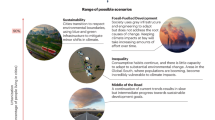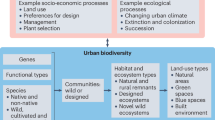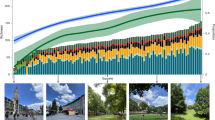Abstract
In the face of global change, cities increasingly need to reconcile people and nature by promoting biodiversity and improving human well-being as acknowledged by the COP15 biodiversity agreement. However, achieving these objectives requires data-informed decision-making to adapt cities to our changing world. Here we argue that the application of modeling frameworks from macroecology represents a big opportunity to precisely understand and inform current and future patterns of urban biodiversity and its contributions to people in cities. By closely collaborating with urban planners and decision-makers, resulting biodiversity outputs could assist urban management to better adapt to climate change, protect biodiversity, and optimize access to nature and its benefits.
This is a preview of subscription content, access via your institution
Access options
Subscribe to this journal
Receive 12 digital issues and online access to articles
$119.00 per year
only $9.92 per issue
Buy this article
- Purchase on SpringerLink
- Instant access to full article PDF
Prices may be subject to local taxes which are calculated during checkout



Similar content being viewed by others
References
Elmqvist, T. et al. Sustainability and resilience for transformation in the urban century. Nat. Sustain. 2, 267–273 (2019).
Simkin, R. D., Seto, K. C., McDonald, R. I. & Jetz, W. Biodiversity impacts and conservation implications of urban land expansion projected to 2050. Proc. Natl Acad. Sci. USA 119, e2117297119 (2022).
Rey, P.-L., Vittoz, P., Petitpierre, B., Adde, A. & Guisan, A. Linking plant and vertebrate species to nature’s contributions to people in the Swiss Alps. Sci. Rep. 13, 7312 (2023).
Rocha, A. D. et al. Unprivileged groups are less served by green cooling services in major European urban areas. Nat. Cities 1, 424–435 (2024).
Shackleton, C. M. & Gwedla, N. The legacy effects of colonial and apartheid imprints on urban greening in South Africa: spaces, species, and suitability. Front. Ecol. Evol. 8, 579813 (2021).
Estien, C. O., Fidino, M., Wilkinson, C. E., Morello-Frosch, R. & Schell, C. J. Historical redlining is associated with disparities in wildlife biodiversity in four California cities. Proc. Natl Acad. Sci. USA 121, e2321441121 (2024).
Lepczyk, C. A., Aronson, M. F. & La Sorte, F. A. Cities as sanctuaries. Front. Ecol. Environ. 21, 251–259 (2023).
Uchida, K. et al. Urban biodiversity and the importance of scale. Trends Ecol. Evol. 36, 123–131 (2021).
Wintle, B. A. et al. Global synthesis of conservation studies reveals the importance of small habitat patches for biodiversity. Proc. Natl Acad. Sci. USA 116, 909–914 (2019).
Dunn, R. R., Gavin, M. C., Sanchez, M. C. & Solomon, J. N. The pigeon paradox: dependence of global conservation on urban nature. Conserv. Biol. 20, 1814–1816 (2006).
Oke, C. et al. Cities should respond to the biodiversity extinction crisis. npj Urban Sustain. 1, 11 (2021).
Acuto, M., Parnell, S. & Seto, K. C. Building a global urban science. Nat. Sustain. 1, 2–4 (2018).
Nilon, C. H. et al. Planning for the future of urban biodiversity: a global review of city-scale initiatives. Bioscience 67, 332–342 (2017).
Perrelet, K., Moretti, M., Dietzel, A., Altermatt, F. & Cook, L. M. Engineering blue–green infrastructure for and with biodiversity in cities. npj Urban Sustain. 4, 27 (2024).
Cook, L. M. et al. Towards the intentional multifunctionality of urban green infrastructure: a paradox of choice? npj Urban Sustain. 4, 12 (2024).
Parris, K. M. et al. The seven lamps of planning for biodiversity in the city. Cities 83, 44–53 (2018).
Guisan, A. et al. Predicting species distributions for conservation decisions. Ecol. Lett. 16, 1424–1435 (2013).
Andersson, E. K., Lyngstad, T. H. & Sleutjes, B. Comparing patterns of segregation in north-western Europe: a multiscalar approach. Eur. J. Popul. 34, 151–168 (2018).
Andersson, E. K. et al. A comparative study of segregation patterns in Belgium, Denmark, the Netherlands and Sweden: neighbourhood concentration and representation of non-European migrants. Eur. J. Popul. 34, 251–275 (2018).
Zumwald, M., Knüsel, B., Bresch, D. N. & Knutti, R. Mapping urban temperature using crowd-sensing data and machine learning. Urban Clim. 35, 100739 (2021).
Casanelles-Abella, J. et al. Applying predictive models to study the ecological properties of urban ecosystems: a case study in Zürich, Switzerland. Landsc. Urban Plan. 214, 104137 (2021).
Planillo, A. et al. Arthropod abundance modulates bird community responses to urbanization. Divers. Distrib. 27, 34–49 (2021).
Schell, C. J. et al. The ecological and evolutionary consequences of systemic racism in urban environments. Science 369, eaay4497 (2020).
EU Biodiversity Strategy for 2030: Bringing Nature Back into Our Lives (EC, 2020).
Sofaer, H. R. et al. Development and delivery of species distribution models to inform decision-making. Bioscience 69, 544–557 (2019).
Knapp, S. et al. A research agenda for urban biodiversity in the global extinction crisis. Bioscience 71, 268–279 (2021).
Ellis-Soto, D., Chapman, M. & Locke, D. H. Historical redlining is associated with increasing geographical disparities in bird biodiversity sampling in the United States. Nat. Hum. Behav. 7, 1869–1877 (2023).
Hortal, J. et al. Historical bias in biodiversity inventories affects the observed environmental niche of the species. Oikos 117, 847–856 (2008).
Dickinson, J. L., Zuckerberg, B. & Bonter, D. N. Citizen science as an ecological research tool: challenges and benefits. Annu. Rev. Ecol. Evol. Syst. 41, 149–172 (2010).
Guisan, A., Thuiller, W. & Zimmermann, N. E. Habitat Suitability and Distribution Models (Cambridge Univ. Press, 2017).
Chauvier, Y. et al. Novel methods to correct for observer and sampling bias in presence‐only species distribution models. Glob. Ecol. Biogeogr. 30, 2312–2325 (2021).
Sandel, B., Merow, C., Serra‐Diaz, J. M. & Svenning, J. Disequilibrium in plant distributions: challenges and approaches for species distribution models. J. Ecol. https://doi.org/10.1111/1365-2745.70009 (2025).
Pollock, L. J. et al. Protecting biodiversity (in all its complexity): new models and methods. Trends Ecol. Evol. 35, 1119–1128 (2020).
Guisan, A. & Thuiller, W. Predicting species distribution: offering more than simple habitat models. Ecol Lett 8, 993–1009 (2005).
Francis, A. P. & Currie, D. J. A globally consistent richness-climate relationship for angiosperms. Am. Nat. 161, 523–536 (2003).
Hahs, A. K. et al. Urbanisation generates multiple trait syndromes for terrestrial animal taxa worldwide. Nat. Commun. 14, 4751 (2023).
Kass, J. M., Fukaya, K., Thuiller, W. & Mori, A. S. Biodiversity modeling advances will improve predictions of nature’s contributions to people. Trends Ecol. Evol. https://doi.org/10.1016/j.tree.2023.10.011 (2023).
Paquette, A. et al. Praise for diversity: a functional approach to reduce risks in urban forests. Urban For. Urban Green. 62, 127157 (2021).
Burton, V. J. & Cameron, E. K. Learning more about earthworms with citizen science. Front. Young Minds 8, 548525 (2021).
Delisle, Z. J., Flaherty, E. A., Nobbe, M. R., Wzientek, C. M. & Swihart, R. K. Next-generation camera trapping: systematic review of historic trends suggests keys to expanded research applications in ecology and conservation. Front. Ecol. Evol. 9, 617996 (2021).
Fairbrass, A. J. et al. CityNet—deep learning tools for urban ecoacoustic assessment. Methods Ecol. Evol. 10, 186–197 (2019).
Deiner, K., Yamanaka, H. & Bernatchez, L. The future of biodiversity monitoring and conservation utilizing environmental DNA. Environ. DNA 3, 3–7 (2021).
Casanelles-Abella, J., Fontana, S., Meier, E. S., Moretti, M. & Fournier, B. Spatial mismatch between wild bee diversity hotspots and protected areas. Conserv. Biol. 37, e14082 (2023).
Chauvier, Y. et al. Resolution in species distribution models shapes spatial patterns of plant multifaceted diversity. Ecography 2022, e05973 (2022).
Faith, D. P. Conservation evaluation and phylogenetic diversity. Biol. Conserv. 61, 1–10 (1992).
Petchey, O. & Gaston, K. J. Functional diversity (FD), species richness and community composition. Ecol. Lett. 5, 402–411 (2002).
Violle, C. et al. Functional rarity: the ecology of outliers. Trends Ecol. Evol. 32, 356–367 (2017).
Hamel, P. et al. Mapping the benefits of nature in cities with the InVEST software. npj Urban Sustain. 1, 25 (2021).
Stange, E. E., Zulian, G., Rusch, G. M., Barton, D. N. & Nowell, M. Ecosystem services mapping for municipal policy: ESTIMAP and zoning for urban beekeeping. One Ecosyst. 2, e14014 (2017).
Faith, D. P. in Phylogenetic Diversity Vol. 1 (eds Scherson, R. & Faith, D. P.) 1–26 (Springer, 2018).
Bratman, G. N. et al. Nature and mental health: an ecosystem service perspective. Sci. Adv. 5, eaax0903 (2019).
Leong, M., Dunn, R. R. & Trautwein, M. D. Biodiversity and socioeconomics in the city: a review of the luxury effect. Biol. Lett. 14, 20180082 (2018).
Watkins, S. L. & Gerrish, E. The relationship between urban forests and race: a meta-analysis. J. Environ. Manag. 209, 152–168 (2018).
Burghardt, K. T. et al. Current street tree communities reflect race‐based housing policy and modern attempts to remedy environmental injustice. Ecology 104, e3881 (2023).
Lang, N., Jetz, W., Schindler, K. & Wegner, J. D. A high-resolution canopy height model of the Earth. Nat. Ecol. Evol. https://doi.org/10.1038/s41559-023-02206-6 (2023).
Erlwein, S., Meister, J., Wamsler, C. & Pauleit, S. Governance of densification and climate change adaptation: how can conflicting demands for housing and greening in cities be reconciled? Land Use Policy 128, 106593 (2023).
Li, Y. et al. Green spaces provide substantial but unequal urban cooling globally. Nat. Commun. 15, 7108 (2024).
Hansen, R., Mattes, A., Meier, M. & Kurths, A. Reorienting urban green infrastructure planning towards biodiversity—perspectives and ongoing debates from Germany. Urban For. Urban Green 90, 128155 (2023).
Diezmartínez, C. V. & Short Gianotti, A. G. US cities increasingly integrate justice into climate planning and create policy tools for climate justice. Nat. Commun. 13, 5763 (2022).
Brelsford, C., Lobo, J., Hand, J. & Bettencourt, L. M. A. Heterogeneity and scale of sustainable development in cities. Proc. Natl Acad. Sci. USA 114, 8963–8968 (2017).
Egerer, M., Fouch, N., Anderson, E. C. & Clarke, M. Socio-ecological connectivity differs in magnitude and direction across urban landscapes. Sci. Rep. 10, 4252 (2020).
Escobedo, F. J., Kroeger, T. & Wagner, J. E. Urban forests and pollution mitigation: analyzing ecosystem services and disservices. Environ. Pollut. 159, 2078–2087 (2011).
Pereira, P. & Baró, F. Greening the city: thriving for biodiversity and sustainability. Sci. Total Environ. 817, 153032 (2022).
Kendal, D. et al. A global comparison of the climatic niches of urban and native tree populations. Glob. Ecol. Biogeogr. 27, 629–637 (2018).
Grünig, M., Mazzi, D., Calanca, P., Karger, D. N. & Pellissier, L. Crop and forest pest metawebs shift towards increased linkage and suitability overlap under climate change. Commun. Biol. 3, 233 (2020).
Hirzel, A. & Guisan, A. Which is the optimal sampling strategy for habitat suitability modelling. Ecol. Modell. 157, 331–341 (2002).
Gavish, Y. et al. Accounting for biotic interactions through alpha‐diversity constraints in stacked species distribution models. Methods Ecol. Evol. 8, 1092–1102 (2017).
Poggiato, G. et al. On the Interpretations of joint modeling in community ecology. Trends Ecol. Evol. 36, 391–401 (2021).
Brun, P. et al. Multispecies deep learning using citizen science data produces more informative plant community models. Nat. Commun. 15, 4421 (2024).
Allen, M. A., Roberts, D. A. & McFadden, J. P. Reduced urban green cover and daytime cooling capacity during the 2012–2016 California drought. Urban Clim. 36, 100768 (2021).
Soanes, K. & Lentini, P. E. When cities are the last chance for saving species. Front. Ecol. Environ. 17, 225–231 (2019).
Chase, J. M., Jeliazkov, A., Ladouceur, E. & Viana, D. S. Biodiversity conservation through the lens of metacommunity ecology. Ann. N. Y. Acad. Sci. 1469, 86–104 (2020).
Simons, A. L. et al. Correction to: Constructing ecological indices for urban environments using species distribution models. Urban Ecosyst. https://doi.org/10.1007/s11252-022-01275-y (2022).
Geppert, C. et al. Temperature and not landscape composition shapes wild bee communities in an urban environment. Insect Conserv. Divers. https://doi.org/10.1111/icad.12602 (2022).
McDonald, J. L. & Skillings, E. Human influences shape the first spatially explicit national estimate of urban unowned cat abundance. Sci. Rep. 11, 20216 (2021).
Baldock, K. C. R. et al. A systems approach reveals urban pollinator hotspots and conservation opportunities. Nat. Ecol. Evol. 3, 363–373 (2019).
Egerer, M. & Anderson, E. Social-ecological connectivity to understand ecosystem service provision across networks in urban landscapes. Land 9, 530 (2020).
Boeing, G. et al. Using open data and open-source software to develop spatial indicators of urban design and transport features for achieving healthy and sustainable cities. Lancet Glob. Health 10, e907–e918 (2022).
Hu, L. et al. Monitoring housing rental prices based on social media: an integrated approach of machine-learning algorithms and hedonic modeling to inform equitable housing policies. Land Use Policy 82, 657–673 (2019).
Mapping inequality. ESRI https://www.arcgis.com/home/item.html?id=e669e5298ba146cc8369f9cbde6eead4 (2024).
Haandrikman, K., Costa, R., Malmberg, B., Rogne, A. F. & Sleutjes, B. Socio-economic segregation in European cities. A comparative study of Brussels, Copenhagen, Amsterdam, Oslo and Stockholm. Urban Geogr. 44, 1–36 (2021).
Dmowska, A. & Stepinski, T. F. High resolution dasymetric model of U.S demographics with application to spatial distribution of racial diversity. Appl. Geogr. 53, 417–426 (2014).
Chauvier, Y. et al. Influence of climate, soil, and land cover on plant species distribution in the European Alps. Ecol. Monogr. 91, 1–14 (2021).
Mijling, B. High-resolution mapping of urban air quality with heterogeneous observations: a new methodology and its application to Amsterdam. Atmos. Meas. Tech. 13, 4601–4617 (2020).
Buchhorn, M. et al. Copernicus Global Land Service: land cover 100m: collection 3: epoch 2015: globe. Zenodo https://doi.org/10.5281/zenodo.3939038 (2020).
Dmowska, A., Stepinski, T. F. & Nowosad, J. Racial landscapes—a pattern-based, zoneless method for analysis and visualization of racial topography. Appl. Geogr. 122, 102239 (2020).
Aiello, L. M., Schifanella, R., Quercia, D. & Aletta, F. Chatty maps: constructing sound maps of urban areas from social media data. R. Soc. Open Sci. 3, 150690 (2016).
Loss, S. R., Will, T. & Marra, P. P. The impact of free-ranging domestic cats on wildlife of the United States. Nat. Commun. 4, 1396 (2013).
Acknowledgements
J.C.-A. was funded by the SNF Postdoc.Mobility fellowship (grant number 217754). J.C.-A. and M.M. acknowledge support from the SNF Synergia program PAPPUS project (grant number 213584) and the BiodivERsA project BioVEINS (grant number 172467). Y.C.-M. and N.E.Z. have been supported by the ANR-SNF bilateral project OriginAlps (grant number 310030L_170059). We thank L. Roux for her support throughout the long processes of writing this Perspective and for the many discussions on the topic. We thank C. Graham for her feedback and also K. Thrace, G. Baltar and W. Adama for their continuing motivation and moral boost.
Author information
Authors and Affiliations
Contributions
J.C.-A. and Y.C.-M. conceived the Perspective and wrote the first version of the paper. All authors revised and corrected the subsequent versions of the paper.
Corresponding authors
Ethics declarations
Competing interests
The authors declare no competing interests.
Peer review
Peer review information
Nature Cities thanks the anonymous reviewers for their contribution to the peer review of this work.
Additional information
Publisher’s note Springer Nature remains neutral with regard to jurisdictional claims in published maps and institutional affiliations.
Supplementary information
Supplementary Information
Supplementary Figs. 1 and 2, and Boxes 1 and 2.
Rights and permissions
Springer Nature or its licensor (e.g. a society or other partner) holds exclusive rights to this article under a publishing agreement with the author(s) or other rightsholder(s); author self-archiving of the accepted manuscript version of this article is solely governed by the terms of such publishing agreement and applicable law.
About this article
Cite this article
Casanelles-Abella, J., Moretti, M., Kleinschroth, F. et al. Biodiversity modeling to manage urban ecosystems for people and nature. Nat Cities 2, 573–584 (2025). https://doi.org/10.1038/s44284-025-00263-5
Received:
Accepted:
Published:
Issue date:
DOI: https://doi.org/10.1038/s44284-025-00263-5



